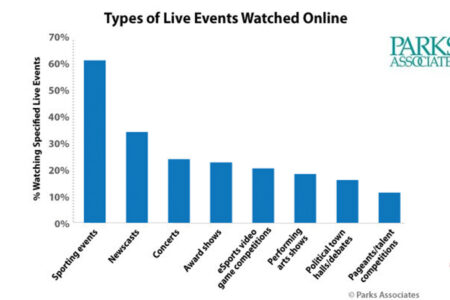New research highlights increasing consumer consumption of livestreaming video
Parks Associates’ new video research, found in Quantified Consumer: Livestreaming: The Next Hot Video Market, finds 43% of US internet households have livestreamed online content in the past three months, with sporting events by far the most popular type of content. Sixty-one percent of livestreaming users have recently watched a live sporting event online, while newscasts, the second most popular type of content, captured only 36% of livestreamers. Parks Associates’ recently published consumer study examines uptake of livestreaming video, the different types of live content that drives consumption, and the platforms and services used for this content.
“Consumers who subscribe to online sports services or those who subscribe to a premium pay-TV sports package are more likely to livestream,” said Paul Erickson, Director of Research, Parks Associates. “Right now, sports content is key to drawing and keeping an engaged livestream viewer base. Even with content that benefits from live consumption – such as news and concerts – significantly fewer consumers are livestreaming this content compared to sports. The sports audience is significantly more engaged in livestreaming as a whole.”
Also Read: Visier Celebrates its Most Successful Customer Conference Yet, with 1,800 Attendees at Outsmart 2022
Parks Associates finds 78% of those who subscribe to an OTT sports service have livestreamed, as opposed to just one-quarter of those who do not subscribe to an OTT sports service. Consumers who regularly livestream content are engaged users. For many, livestreamed content is their primary content consumption. Consumers who livestream estimate that live online content comprises close to half of their total online video consumption. Among heavy livestream viewers, on-demand content comprises just over one-quarter of their online video consumption.
“Offering livestreaming content is an opportunity for services to draw both the highly engaged heavy livestreaming audience and livestream-centric older audiences,” Erickson said. “Consumers in the higher age brackets can be difficult to target, but livestreaming is one option that appeals to them, provided the provider delivers the right content.”

